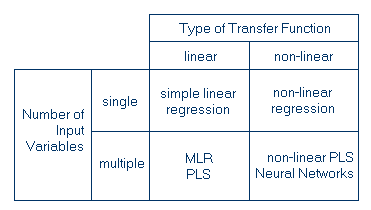 You are working with the text-only light edition of "H.Lohninger: Teach/Me Data Analysis, Springer-Verlag, Berlin-New York-Tokyo, 1999. ISBN 3-540-14743-8". Click here for further information.
You are working with the text-only light edition of "H.Lohninger: Teach/Me Data Analysis, Springer-Verlag, Berlin-New York-Tokyo, 1999. ISBN 3-540-14743-8". Click here for further information.
 You are working with the text-only light edition of "H.Lohninger: Teach/Me Data Analysis, Springer-Verlag, Berlin-New York-Tokyo, 1999. ISBN 3-540-14743-8". Click here for further information. You are working with the text-only light edition of "H.Lohninger: Teach/Me Data Analysis, Springer-Verlag, Berlin-New York-Tokyo, 1999. ISBN 3-540-14743-8". Click here for further information.
|
Table of Contents  Bivariate Data Bivariate Data  Calibration Calibration |
|
| See also: multivariate calibration, regression |   |
When performing an experiment, the parameters measured immediately are often not the parameters the experimenter is interested in. Someone may be interested, for example, in the concentration of a substance while measuring absorbances at certain wavelengths. In order to find the relationship between the actually measured data (i.e. the absorbances) and the property of interest (i.e. the concentration), one has to set up a calibration, i.e. a functional relationship between the measured data and the parameters of interest.

The calibration of an instrument is only possible if one knows which
type of model to apply. Start the following![]() to see several aspects of models and calibration.
to see several aspects of models and calibration.
In general, one should ensure that the number of calibration points
exceeds the number of parameters to be determined. A rule of thumb states
that one should use at least three times as many calibration points as
parameters. This means that for a simple linear univariate calibration
curve, you should use 6 calibration points (a line is determined by two
parameters).
Last Update: 2006-Jšn-17